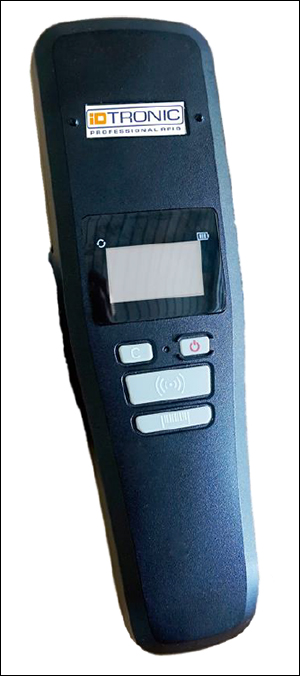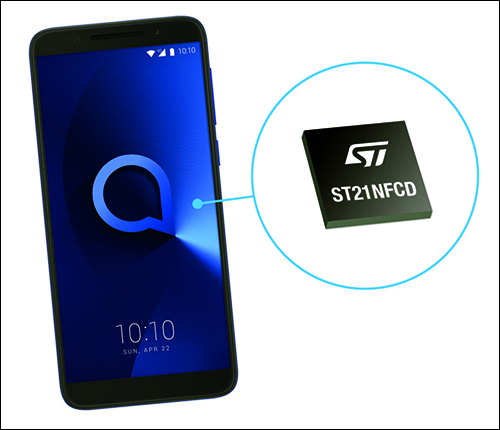The following are news announcements made during the past week by the following organizations:
Wade Garcia & Associates, InCom;
iDTRONIC;
STMicroelectronics, TCL Communication;
Balluff;
Electric Imp; and
Quuppa.
Wade Garcia & Associates, InCom Enter Licensing Agreement for RFID Attendance-Taking System
Wade Garcia & Associates and InCom have entered into a nonexclusive licensing agreement for InCom’s patented RFID-based attendance-taking technology (US patent numbers 7,336,185B2 and 8,353,705 B2). Wade Garcia provides RFID systems for attendance tracking, bus transportation security and emergency situations in schools.
“This agreement will enhance Wade Garcia’s market position, which offers the only RFID-based system that helps protect students and teachers during a catastrophic event,” said Mike Wade, Wade Garcia’s owner, in a prepared statement. “The system will allow for first-responders to know where the incidents are taking place and locate those who might still be in the area. It is expected that the alert system will enhance campus security and target law-enforcement response.”
“We are very pleased with this agreement and the opportunity to see RFID attendance taking expand into larger school districts,” said Bernie DiDario, InCom’s co-founder and CEO, in the prepared statement. “Recent tragic and unfortunate events have again focused attention on security, safety and accountability for our students, their parents and teachers. We understand this, as three of four InCom founders and one board member continue to work in an educational setting.”
According to West, RFID increases accountability and provides immediate attendance-taking data, and also contributes to increased accuracy, lessening the burden on teachers and administrators. “RFID can do this quickly and accurately,” he said, “while assuring the privacy of students and student information.”
iDTRONIC Releases New Handheld RFID Computer
iDTRONIC has announced its I-Poll2.0 data-collector, which combines RFID and bar-code reading capabilities. The UHF reader provides a reading range of up to 4 meters. The I-Poll2.0 can be equipped with 1D or 2D bar-code-scanning options for a range of Internet of Things and Industry 4.0 applications, the company reports.

Communication options via Bluetooth v4.1 or USB and Magconn offer real-time communication for many scanning solutions. Communication can be handled through classical virtual comport communication or as a read-only version with an HID option. As a host system, the I-Poll2.0 supports Microsoft Windows, Android, iOS and MAC operating systems.
In addition, the device can be operated independently due to internal memory for up to 1,000 datasets and its 1.3-inch BLUE OLED display. An internal 3.3mAh lithium-ion polymer battery allows for remote working shifts of up to 10 hours, and can be recharged via an integrated Magconn connector. Available accessories include desktop cradles, hand straps and USB dongles.
STMicroelectronics’ NFC Technology Powers New TCL Communication Smartphone
STMicroelectronics, a global semiconductor company serving customers in electronics applications, has announced that its Near Field Communication (NFC) technology is powering the contactless features of TCL Communication‘s newly launched Alcatel 3V smartphone for the European market.
TCL Communication selected ST’s NFC controller chip for its technology that boosts RF performance without draining battery life. ST’s technology allows connectivity for contactless payments, e-ticket transactions, peer-to-peer data transfer and emerging use cases, such as interacting with “physical Web” objects like smart posters and store shelves.

“We are pleased to partner with ST to equip Alcatel 3V with reliable and secure contactless connections for our customers around the globe and to provide even richer experiences and superior interoperability throughout the numerous contactless terminals in their everyday lives,” said Stefan Streit, TCL’s general manager for global marketing, in a prepared statement. “The support provided by ST and the highly effective collaboration between our technical teams helped us quickly achieve the applicable certifications for the Alcatel 3V.”
“The high RF performance of ST’s NFC solution maximizes freedom and flexibility to optimize new product designs,” said Laurent Degauque, the marketing director of ST’s Secure Microcontroller Division, in the prepared statement. “Leveraging that flexibility effectively streamlined NFC integration on the Alcatel 3V smartphone, ultimately ensuring shorter time to revenue for our customer, TCL Communication.”
ST and TCL intend to extend their collaboration to integrate ST’s hardware digital-security solutions into future TCL Communication products. ST offers miniaturized, low-power chips, including an embedded Secure Element (eSE) for cryptography and key storage and combined NFC/eSE devices, which are certified to Common Criteria EAL5+ and EMVCo security standards for financial applications. ST also provides a range of solutions and form factors for eSIM.
The ST21NFCD integrates an NFC controller and RF circuitry that meet NFC Forum type 1-5 tag specifications, ISO/IEC 18092 NFC Interface and Protocol (NFCIP), and RFID and payment standards, including ISO 15693, ISO/IEC 14443 Type A & B, JIS X 6319–4 and MIFARE. ST’s active load modulation technology leverages synchronization with a reader’s RF field to boost signal strength and ensure reliable coupling during data exchanges, according to the company. This gives designers greater flexibility to use smaller antenna sizes and minimize system power consumption for longer battery life, while facilitating contactless transactions.
The ST21NFCD contains many integrated features that minimize circuit size and bill-of-materials costs. These include a clock generator (with the option to use an external reference clock or quartz crystal), as well as on-chip power-management and battery-voltage monitoring that boost energy efficiency and extend run-time. Integrated eFlash with a secure firmware update mechanism also provides flexibility to apply upgrades and security packs over the air.
Balluff Magnetic Mount Simplifies RFID Integration
Balluff has announced that its new break-off magnetic mount with tag holder allows for easy integration of RFID systems. Using a magnetic connection, the solution is suitable for presses for which frequent tool or size changes are required.
The magnetic mounts are designed to make it easier to align read-write heads and help in the continuity of the RFID signal, the company reports. What’s more, the devices protect the heads from accidental damage.
“Whether it is being utilized in a die ID application to ensure the right die is loaded for the right job or for a work-in-process application where the work piece is dynamic, the magnetic mount is an ideal solution for ensuring the reader and the tag maintain constant communication,” said Wolfgang Kratzenberg, Balluff’s RFID product marketing manager, in a prepared statement.
“In addition,” Kratzenberg said, “if the operator fails to disengage the reader, the magnetic mount simply breaks away from the work piece causing no harm to the reader.”
Electric Imp Intros Cellular IoT Service
Electric Imp, a provider of secure edge-to-enterprise cloud Internet of Things (IoT) connectivity, has announced its impCellular system, which provides cellular communication to its IoT platform. impCellular leverages Electric Imp’s platform architecture to simplify the process of developing, shipping and maintaining cellular-connected devices. With impCellular, the company reports, customers are never exposed to SIMs, activation, complex price plans or burdensome carrier requirements.
“We developed impCellular specifically to solve the complex, time-consuming and costly development process involved in most cellular IoT projects,” said Hugo Fiennes, Electric Imp’s CEO and co-founder, in a prepared statement. “With the addition of cellular connectivity, our customers have another compelling option to easily, rapidly and cost-effectively achieve zero-install secure connectivity for their IoT applications. The complete connectivity package is combined with our standard edge-to-cloud security and lifecycle management services to help customers maximize the potential of real-time connectivity without the traditional complexities of deploying connected devices at scale.”
Hybrid operation modes are supported, allowing devices to securely use lower-cost networks when available. For example, telematics applications can send high volumes of buffered sensor data via Wi-Fi when a truck is at a loading bay, but only transmit location data and alerts via a cellular connection when the vehicle is moving. Cellular backup can be used to improve the reliability of stationary applications, such as smart vending machines.
One early customer of impCellular is Operant Solar, which developed a mesh-networked monitoring system for solar panel installations that initially used imp005-powered Wi-Fi backhaul. “The changes required to move our product to cellular literally took us one afternoon,” said Rod Sugiyama, Operant Solar’s COO, in the prepared statement. “The Electric Imp Platform allows us to provide resilient, trouble-free internet connectivity for photovoltaic inverters at a very attractive cost point.”
The initial impCellular product is the impC001, which offers LTE cat 1 and 3G operation combined with local processing and a range of I/O applications. Models of the impC001 are available for the United States, Europe and Australia/New Zealand. Expected during the fourth quarter of 2018 is the impC002, which will contain a global Cat-M / NB-IoT radio. Pricing for Electric Imp’s cellular connectivity is based on the number of devices connected each month, with cellular data allowances automatically pooled across a customer’s account and with no charges for devices that do not connect.
Quuppa to Host Partner Event for Indoor Location Services
Quuppa, a provider of indoor-positioning technology, has announced that its second annual partner event will take place on June 5-7 in Helsinki, Finland. With a theme of “Defining the Future,” the event will feature speakers from Quuppa and its partner ecosystem, networking events and a Solutions Showcase Expo that will demonstrate the current and future capabilities of real-time, global indoor-location services and solutions.
The event will highlight case-study presentations showcasing use cases for Quuppa’s indoor-location technology. Featured topics will include improving efficiency and customer experience in retail, asset tracking in large scale, Industry 4.0, manufacturing use cases from Japan, safety in a secure environment, generating business KPIs from location data, and employee safety indoors and outdoors.
Quuppa utilizes a combination of Bluetooth Low Energy (BLE) and angle-of-arrival (AoA) methodologies, as well as location algorithms, to calculate indoor positioning. “Quuppa’s ecosystem continues to thrive, and our partner event is a place to gather and share expertise and best practices for global indoor location services,” said Fabio Belloni, the head of Quuppa’s Partner Ecosystem, in a prepared statement.
“What we are seeing more of as the ecosystem expands is partner companies seeking answers from their peers—not just from Quuppa—on wide-ranging topics such as how to launch a large-scale deployment, how to forge partnerships to grow in new geographic areas, how to best conduct a demo, and more,” Belloni added in the prepared statement. “Companies are realizing they no longer need to develop everything on their own, they can choose best-of-breed solutions from our incredible ecosystem partners. It’s amazing to see how quickly the Quuppa Ecosystem is growing and the unique partnerships that are forming because of it.”
One such partnership that has emerged within the Quuppa Ecosystem is between Japanese motor manufacturer Nidec Corp. and Synapses Lab, an Italian technology design firm. The companies work together utilizing Quuppa’s precision location technology, Synapses’ platform for tracking and 3D modeling, and Nidec’s electronics and engineering expertise to develop autonomous solutions intended to improve productivity and security in the manufacturing industry.
“Building a solid and reliable ecosystem is essential for our company,” said Domenico Mariotti, Synapses’ CEO and co-founder, in the prepared statement. “Such a system enables us to tackle new challenges and different use cases every day, sometimes beating any expectations we ourselves had for our solutions.”
“In the Japanese manufacturing industry, some early birds are now trying to introduce IoT to their factories,” added Hiroshi Mochizuki, from Nidec’s Small Precision Motor and Solutions business unit, in the prepared statement. “They do not allow position data to have jitter, so Nidec decided to select Synapses’ platform utilizing the Quuppa Ecosystem. Synapses has successfully developed its platform, of which the filtering capability and database structure is duly optimized for Quuppa’s technology.”

